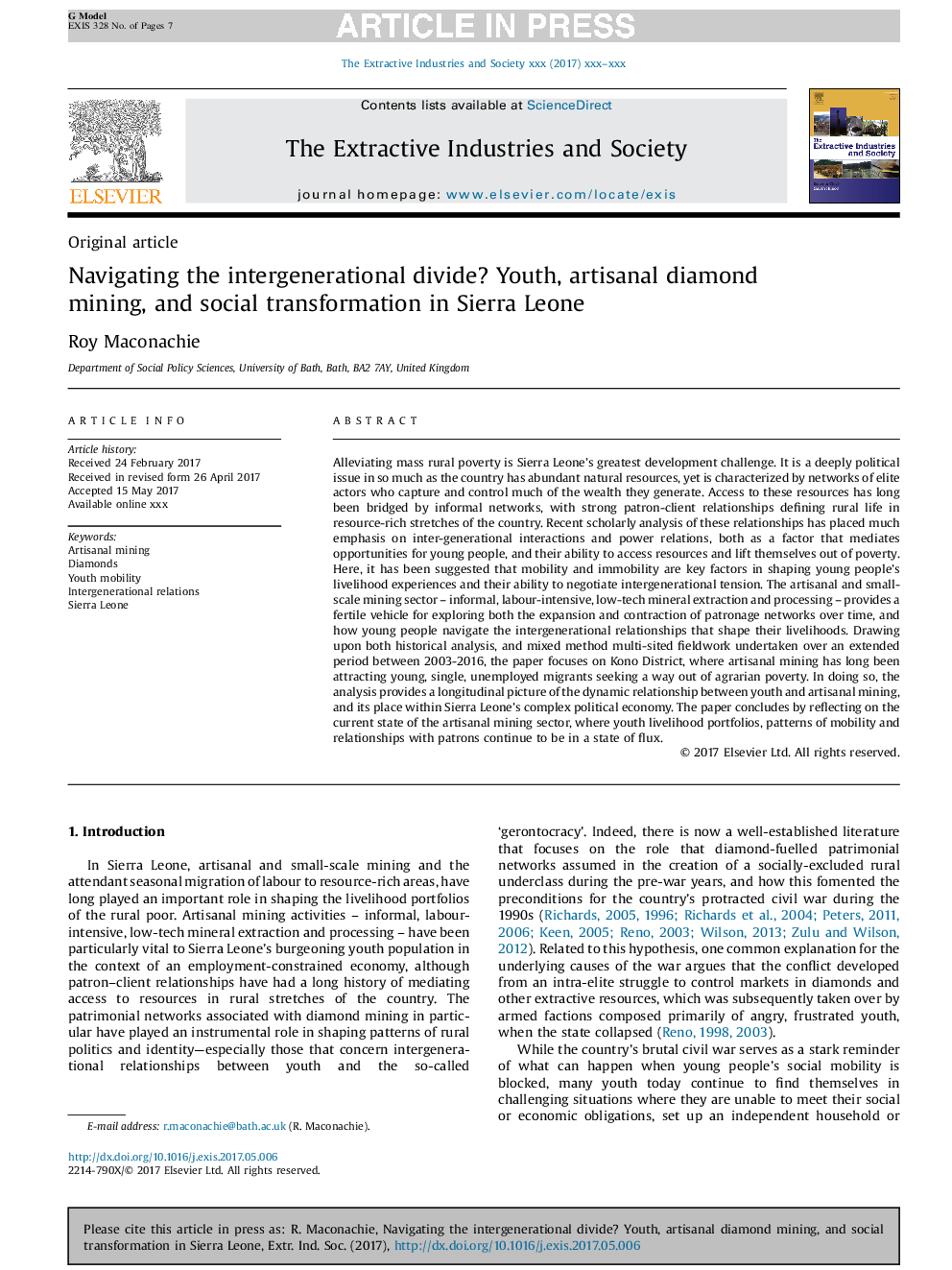| کد مقاله | کد نشریه | سال انتشار | مقاله انگلیسی | نسخه تمام متن |
|---|---|---|---|---|
| 7454303 | 1484418 | 2017 | 7 صفحه PDF | دانلود رایگان |
عنوان انگلیسی مقاله ISI
Navigating the intergenerational divide? Youth, artisanal diamond mining, and social transformation in Sierra Leone
ترجمه فارسی عنوان
حرکت به تقسیم بین نسلی؟ جوانان، معادن الماس و صنایع دستی و تحولات اجتماعی در سیرالئون
دانلود مقاله + سفارش ترجمه
دانلود مقاله ISI انگلیسی
رایگان برای ایرانیان
کلمات کلیدی
استخراج معادن، الماس، تحرک جوانان، روابط بین نسلی، سیرا لئون،
ترجمه چکیده
کاهش فقر فقر روستایی، بزرگترین چالش توسعه سیرالئون است. این مسئله عمیقا سیاسی است به طوری که کشور دارای منابع طبیعی فراوانی است، با این حال شبکه های بازیگران نخبه ای که بسیاری از ثروت هایی را که تولید می کنند را کنترل می کنند و کنترل می کنند. دسترسی به این منابع به مدت طولانی توسط شبکه های غیر رسمی متصل شده است و روابط مشتریان و مشتریان آن، تعریف زندگی روستایی در امتداد منابع غنی کشور است. تجزیه و تحلیل علمی اخیر از این روابط تاکید زیادی بر تعاملات بین نسلی و روابط قدرت، هر دو به عنوان عاملی است که میان جوانان فرصت می دهد و توانایی آنها برای دسترسی به منابع و از بین بردن فقر را تأمین می کند. در اینجا پیشنهاد شده است که تحرک و بی حرکت بودن عوامل اصلی در شکل دادن تجربه های معیشت جوانان و توانایی آنها در مذاکره در مورد تنش بین نسلی است. صنایع استخراجی و معادن کوچک - استخراج و پردازش مواد معدنی غیر متمرکز و کارآمد - با استفاده از تکنولوژی پایین تکنولوژی را برای کشف گسترش و انقباض شبکه های حمایت کننده در طول زمان فراهم می کند و نحوه حرکت جوانان به روابط بین نسلی که شکل می گیرد معیشت آنها با توجه به تحلیل های تاریخی و روش متفاوتی که چندین سال است که در طول دوره های طولانی بین سال های 2003 تا 2016 انجام می شود، مقاله بر روی ناحیه کنو تمرکز می کند که در آن استخراج از معادن بنیادین، مهاجران جوان، تنها، بیکار را به دنبال راهی برای خروج از فقر کشاورزی . در انجام این کار، تجزیه و تحلیل تصویری طولانی از رابطه پویا بین جوانان و معادن استثنایی و جایگاه آن در اقتصاد پیچیده سیاسی سیرالئون فراهم می کند. این مقاله با بازتاب وضعیت فعلی معدنکاری صنایع دستی، که در آن معامله گران معیشت جوانان، الگوهای تحرک و روابط با مشتریان، در وضعیت شتاب قرار دارند، نتیجه گیری می شود.
موضوعات مرتبط
علوم زیستی و بیوفناوری
علوم محیط زیست
مدیریت، نظارت، سیاست و حقوق
چکیده انگلیسی
Alleviating mass rural poverty is Sierra Leone's greatest development challenge. It is a deeply political issue in so much as the country has abundant natural resources, yet is characterized by networks of elite actors who capture and control much of the wealth they generate. Access to these resources has long been bridged by informal networks, with strong patron-client relationships defining rural life in resource-rich stretches of the country. Recent scholarly analysis of these relationships has placed much emphasis on inter-generational interactions and power relations, both as a factor that mediates opportunities for young people, and their ability to access resources and lift themselves out of poverty. Here, it has been suggested that mobility and immobility are key factors in shaping young people's livelihood experiences and their ability to negotiate intergenerational tension. The artisanal and small-scale mining sector - informal, labour-intensive, low-tech mineral extraction and processing - provides a fertile vehicle for exploring both the expansion and contraction of patronage networks over time, and how young people navigate the intergenerational relationships that shape their livelihoods. Drawing upon both historical analysis, and mixed method multi-sited fieldwork undertaken over an extended period between 2003-2016, the paper focuses on Kono District, where artisanal mining has long been attracting young, single, unemployed migrants seeking a way out of agrarian poverty. In doing so, the analysis provides a longitudinal picture of the dynamic relationship between youth and artisanal mining, and its place within Sierra Leone's complex political economy. The paper concludes by reflecting on the current state of the artisanal mining sector, where youth livelihood portfolios, patterns of mobility and relationships with patrons continue to be in a state of flux.
ناشر
Database: Elsevier - ScienceDirect (ساینس دایرکت)
Journal: The Extractive Industries and Society - Volume 4, Issue 4, November 2017, Pages 744-750
Journal: The Extractive Industries and Society - Volume 4, Issue 4, November 2017, Pages 744-750
نویسندگان
Roy Maconachie,
